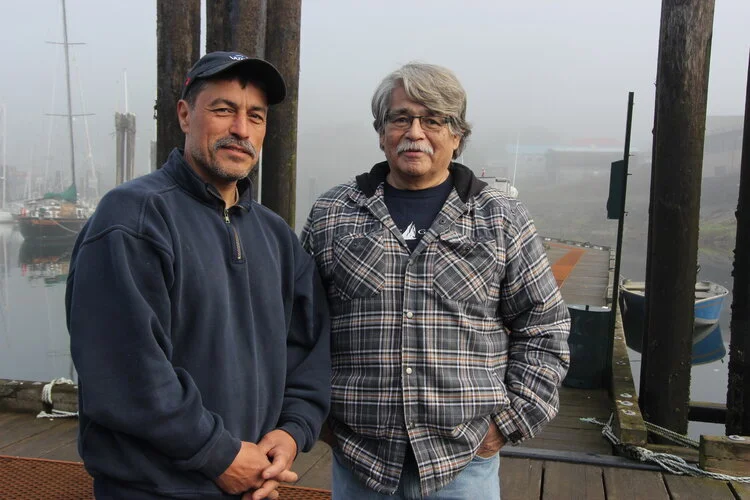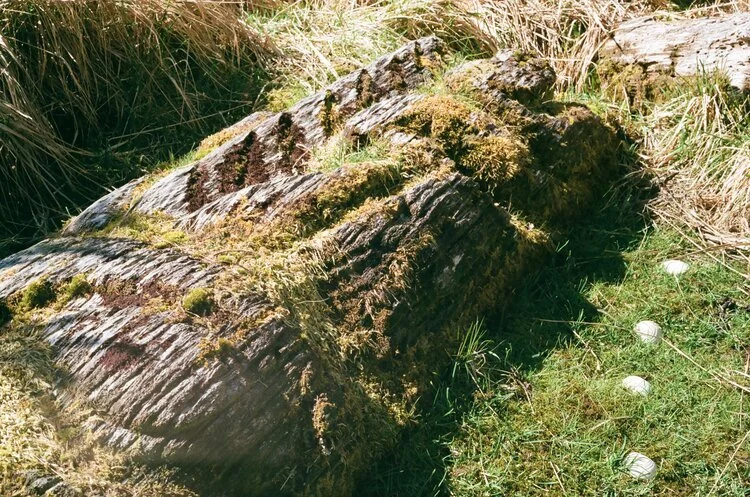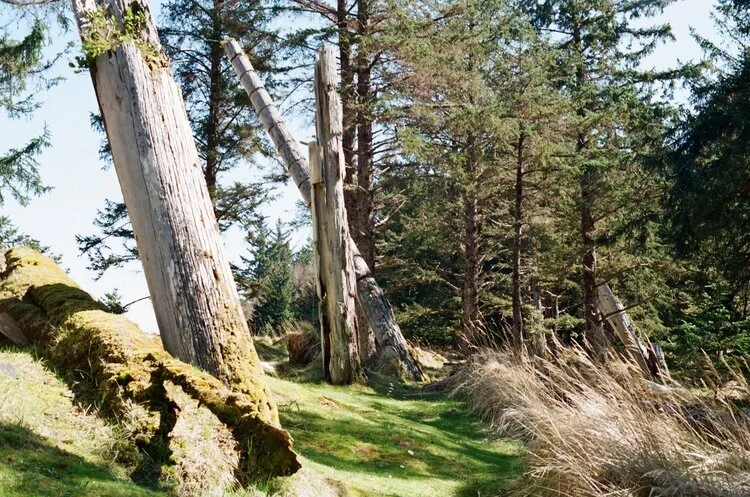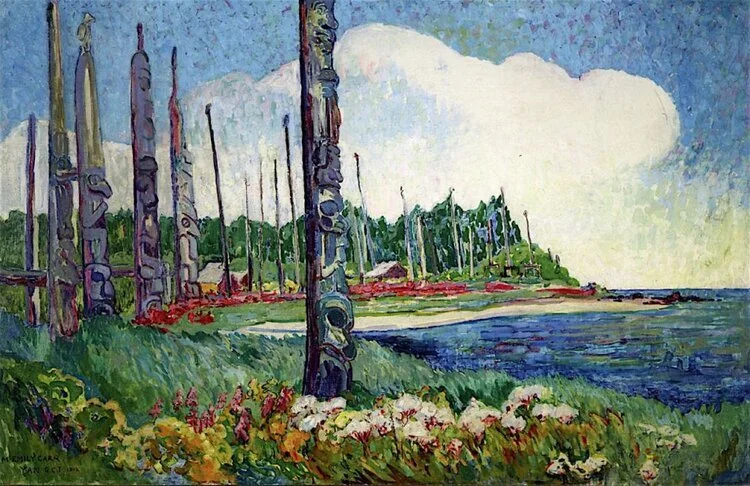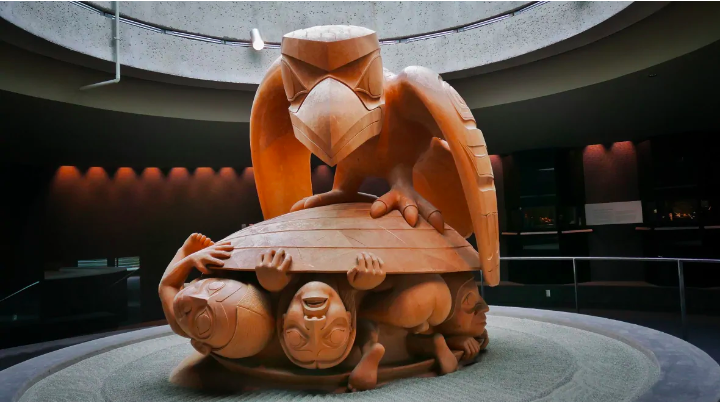Haida Gwaii
The morning mist lifting to reveal stunning vistas. (Photo: Trixie Pacis)
The Highland Ranger banked sharply as it turned into a small, forgotten cove. As the captain killed the engine, the sudden quiet roused us out of our hoods and scarves. We were gliding into the embrace of wind-twisted pines, towards a lonely shore. We disembarked onto the pebbly beach, relieved to be on land and eager to explore the historic indigenous settlement of K’uuna.
K’uuna village was once the beating heart of Haida Gwaii, an archipelago of 150 islands located between Vancouver Island and the southern tip of the Alaskan Panhandle. We had flown in from Vancouver on a small propeller plane, its age belied by the presence of lavatory ashtrays. Formerly known as the Queen Charlotte Islands, Haida Gwaii was renamed in 2010 as part of a restitution agreement between the indigenous Haida Nation and the provincial government of British Columbia.
Despite its pristine wilderness earning it a spot on National Geographic’s list of ‘must-see places in the world’, it seems that relatively few have heard of it, let alone visited. For us, the notion of exploring Haida Gwaii came from an unexpected source—a chance meeting with a German hitchhiker. The almost spiritual wonder with which he spoke about the island resonated; we were curious to see if it would evoke a similar response in ourselves.
On the road to the Queen Charlotte harbour earlier that morning, we interrupted a convocation of eagles circling their roadkill breakfast. We passed reverently, counting seven Bald Eagles perched in the trees above, their watchful eyes tracking us. Though we were tempted to linger, we had a boat to catch.
Captain Volker and Watchman Walter at the marina. (Photo: Trixie Pacis)
We arrived at the Queen Charlotte docks as the morning sun burned through the mist, revealing pine-covered islands and snow-capped mountains. We marched down the gangway with extra layers and flasks of steaming coffee and met Danny, the cheerful owner of Highlander Marine Services.
The guiding season doesn’t technically begin until May, and his company doesn’t typically offer guided tours, so it was by a stroke of luck and generosity that an expedition came together at all. Coincidentally, Danny had been on our flight to Haida Gwaii and worked some magic for us. He arranged our passage into Gwaii Haanas, a National Park Reserve and UNESCO World Heritage site that comprises the southern-third of the island.
The Highland Ranger, our trusty vessel. (Film Photo: Trixie Pacis)
We boarded the Highland Ranger, two of twelve Haida Gwaii first-timers from around the world. To prove that the vessel was sound, Danny wryly explained that the Ranger had once even been used to recover a decomposing grey whale from the harbour. He introduced us to Captain Volker, a man who’d worked his entire career on local waters, and our guide Walter, who’d spent many summers leading tours through the historic sites of Gwaii Haanas. K’uuna (known as Skedans by early European fur traders) would be our first stop. We sped southwards, whipped by crisp winds, sprayed by heavy waves, and battered by the rise and fall of the boat’s metal hull.
Though breathtaking vistas and a thrilling encounter with a pod of grey whales eased any discomfort, we were relieved to reach K’uuna. At first glance, it didn’t appear to be much. In place of the well-preserved Haida village we had perhaps naively envisioned, we found a lush patch of forest nestled beneath a steep cliff and flanked on either side by a rocky, driftwood-laden beach. The only visible dwelling was a newly constructed cabin that housed the summer watchmen, locals who maintain and protect the site throughout the ‘busy’ tourist season. Walter had spent many summers as a watchman and it wasn’t until he began to walk us along K’uuna’s winding trails, painstakingly marked with white clamshells, that we began to grasp the extent of the history they watch over.
A fallen mortuary pole resting on the ground and cordoned off by white clamshells. (Film Photo: Trixie Pacis)
The ancestors of the Haida Nation reached the islands of Haida Gwaii some 13,000 years ago. They developed a complex culture harmoniously intertwined with the abundant resources of land and sea. At one point, as many as 100 villages had cropped up throughout the archipelago—vibrant enclaves of skilled artists, seafarers, warriors and traders. European contact, which began in the late the 18th century, was initially an economic boon for many Haida clans who used their trading prowess to take advantage of the insatiable foreign demand for fur pelts.
This relationship ultimately led to tragic consequences as diseases transmitted by the European traders and subsequent Christian missionaries decimated indigenous populations, wiping out 90% of the Haida people in a matter of decades. The scourge of smallpox, measles, and tuberculosis was so virulent that by 1890, the vast majority of villages had been abandoned entirely. We learned of this as we walked the paths of K’uuna, the white clamshells preventing us from unwittingly disturbing human remains. They were a stark reminder of the catastrophic fate that had befallen the island, its people.
Before the epidemic, the village was home to over 700 people. They lived in thirty communal longhouses lining the sheltered bay. Walter showed us all that remained of these dwellings—rectangular depressions in the soil, now overgrown.
Fallen roof beams and mortuary polls, both under blankets of moss. (Photo: Trixie Pacis)
Walter began to paint the history of his people. He pointed out four cedar corner posts—waist high and rotting —that once supported a longhouse. He described how numerous families lived, cooked and socialized under one roof. They were clearly once impressive structures, sometimes up to 30 meters long and over 15 meters wide; however, despite their size, custom required them to be constructed in just one day. According to Walter, the superstitious villagers feared that evil spirits would occupy the building site if it was left incomplete overnight.
The residents of a particular longhouse were rarely involved in the building of their own home; that task was given to members of neighbouring clans—a tradition designed to promote peace and unity throughout the community. Intricately carved and painted “house poles’, once adorning the front of the homes embodied totems of revered animals; orca, grizzly bear or mythological thunderbird. Each represented the identity, lineage, and social standing of its occupants. The shores were once also dotted with ‘mortuary poles’ honouring past chiefs and other prominent individuals. The largest of the Haida poles, these had a cavity at the top where the remains were enshrined, allowing the physical body to return to nature while providing an earthly home for the spirit of the deceased.
K’uuna’s leaning mortuary poles. (Film Photo: Trixie Pacis)
Many totem poles once towered over K’uuna. Of the few that remain, many lean at alarming angles still defying gravity. Others lay flat on their backs, tucked beneath a blanket of moss in various stages of decomposition. Walter pointed to a faded carving of a bear. We crowded around the fallen pole, straining to glimpse the faint outline. He has seen such a dramatic deterioration in the poles that he believes they will be unrecognizable in as little as a decade.
Instinctively, we asked, “Shouldn’t all of this be preserved?” Walter paused before replying, “In our culture, we believe that everything should be allowed to return to the earth”. His simple yet profound response provoked a fascinating discussion that continued throughout the day as much of what we observed circled back to the delicate and often contentious issue of cultural preservation.
Emily Carr (1871–1945), Yan, Q.C.I. (1912), oil on canvas, 99.5 x 153 cm. Art Gallery of Hamilton, Hamilton, ON. The Athenaeum.
At one point, Walter turned our attention to a mortuary pole and indicated that it was one of many painted by Emily Carr, the renowned British Columbian artist who travelled to Haida Gwaii in 1912. Her whimsical paintings portray these coastal settlements at a time when Haida culture was thriving. Carr was not the only one to show interest or concern; there were various other attempts by outsiders to record Haida history. Anthropologist Wilson Duff led an expedition to ‘salvage’ artifacts from the village in response to the encroachment of the logging industry in the 1950s, the repercussions of which were still evident in the scarred terrain beneath our feet and the tire tracks made at alarming proximity to several mortuary poles.
Facing such threats, many poles were cut down, rolled to the beach using logs, and carted off to various places. It is suspected that a container of poles—some no doubt from K’uuna—is to this day stored at the University of British Columbia, neither displayed nor allowed to return to the earth. Though Duff had obtained permission, we got the sense there were, and likely still are, members of the Haida Nation who feel his actions were a sacrilege. Towards the end of our tour, we passed a mortuary pole, slanting forty-five degrees but supported by a makeshift wooden brace. Walter shook his head, “I don’t know who did this but it’s not the Haida way—it should’ve been left to fall.”
Emily Carr (1871–1945), Cumshewa (1912), watercolour with graphite and gouache on hardboard, 55.8 x 75.4 cm, Private collection. The Athenaeum.
At the end of a long day, which included a stop at Tanu, a larger Haida site and the final resting place of celebrated sculptor Bill Reid, it was time to return. As the Ranger pulled away, we were struck once more by the island’s pristine nature; from our vantage point, there was no sign that we—nor 13,000 years worth of thriving, industrious inhabitants—had ever set foot ashore. Sailing north towards the Queen Charlotte harbour, we reflected on what Walter called the ‘Haida way’; an understanding of equilibrium and a willingness to let nature take its course. We realized that behind us was one of few truly wild places remaining in the world, one that wouldn’t exist without the Haida Nation’s continued practice and defence of their ancestral beliefs.
Engulfed in Vancouver’s cityscape, we couldn’t stop thinking about Haida Gwaii or its history. We visited the UBC Museum of Anthropology (MOA), where many treasures are kept. We started at The Raven and the First Men, a seminal Bill Reid sculpture, then roamed the adjacent gallery. It was filled with totem poles and wooden chests, each one transplanted from the wilds of Haida Gwaii to a modern, climate-controlled room. We also visited an outdoor exhibit where several replica poles and two impressive longhouses stand at full scale. While it helped us to better visualize what K’uuna and Tanu might have looked like, we couldn’t help but notice that the man-made beach upon which it was staged was a poor imitation of its wilderness counterpart. We were truly fortunate to explore it all in person.
The Raven and the First Men by Bill Reid depicting the birth of the Haida people (Photo: CBC).
On the one hand, the exhibit serves to preserve Haida culture. With the MOA drawing 150,000 visitors annually, we can only imagine what that foot traffic would do to K’uuna’s lightly trodden pathways. On the other hand, we left the museum wondering whether these artifacts were being deprived of their natural resting place.
As you read this, wind and rain are smoothing away physical traces of the Haida people from their native lands. Tree roots grow through the fallen poles, absorbing and recycling their nutrients. In our lifetimes, the last remaining wilderness carvings will become indistinguishable, then disappear entirely. Though the footprints of the early Haida people on the land may have faded, the ‘Haida way’ lives on—in Walter’s words of wisdom, in the continued carving and raising of totem poles, and in the evolution of the culture to balance modernity with tradition.
We got the impression that the people of K’uuna would have been content to see their poles returning to the earth, so long as their traditions and values remained. Though we were moved by the pristine beauty of Haida Gwaii, its custodians and their primordial relationship with nature that has been most inspiring. We returned home without any souvenirs or material artifacts, but a story worth passing on. This is the legacy we should immortalize.

